“Australia is about to enter a boom that should last decades…The Australian dollar is unlikely to go back to where it was, and manufacturing will shrink in importance to the economy, perhaps even faster than it has been.” This, according to Martin Parkinson, Treasury Minister of Australia. While 30 years from now, Mr. Parkinson’s prognosis might probe to be accurate, I’m not so sure it applies to the period 3 months from now. Here’s why:
First of all, the putative economic boom that is taking place in Australia is being driven entirely by high commodity prices and surging production and exports. Since peaking at the end of April, commodity prices have fallen mightily. You can see from the chart above that there continues to exist a tight correlation between the AUD/USD and commodities prices. As commodities prices have fallen over the last two months, so has the Australian Dollar.
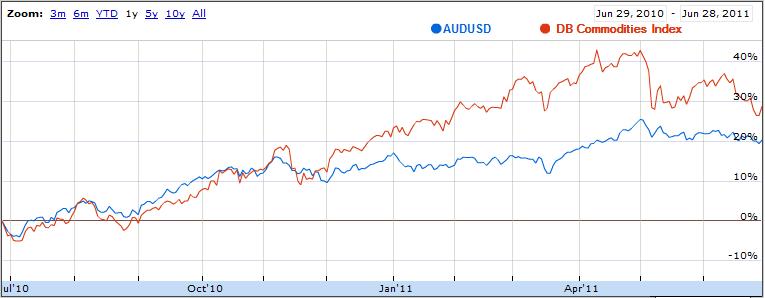
In addition, while demand will probably remain strong over the long-term, it may very well slacken over the short-term, due to declining economic growth across the industrialized world. Consider also that Australia’s largest market for commodity exports – China – may have difficulty sustaining a GDP growth rate of 10%, and at the very least, new fixed-asset investment (which necessitates demand for raw materials) will temporarily peak in the immediate future.
Finally, the mining sector directly accounts for only 8% of Australia’s economy, which means that only to a limited extent to high commodities prices contribute to the bottom line of Australian GDP. This notion is reinforced by the 1.2% economic contraction in the second quarter – the biggest decline in 20 years – and the fact that GDP is basically flat over the last three quarters. Many non-mining economic indicators are sagging, and the number ofcorporate bankruptcies is 10% higher than in 2010. In the end, then, the ebb and flow of Australia’s fortune depends less on commodities, and more on other sectors.
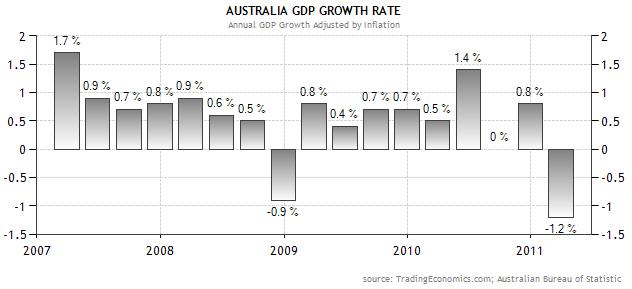
Mr. Parkinson’s optimistic forecasts might also be undermined in the short-term by a looser-than-expected monetary policy. The Reserve Bank of Australia last hiked its benchmark interest rate in November 2010, and may not hike again for a few more months due to moderating economic growth and proportionally moderate inflation. Given that an attractive interest rate differential may be driving some of the speculative activity that has girded the Aussie’s rise, a decline in this differential could likewise propel it downward.
That’s because anecdotal reports suggest that the Australian Dollar remains a popular long currency for carry traders, funded by shorting the US Dollar, and to a lesser extent, Japanese Yen. Given that many of these carry trades are heavily leveraged, it wouldn’t take much to trigger a short squeeze and a rapid decline in the AUD/USD. For evidence of this phenomenon, one has to look no further back than May 2010, when the Aussie fell 10-15% in only three weeks.
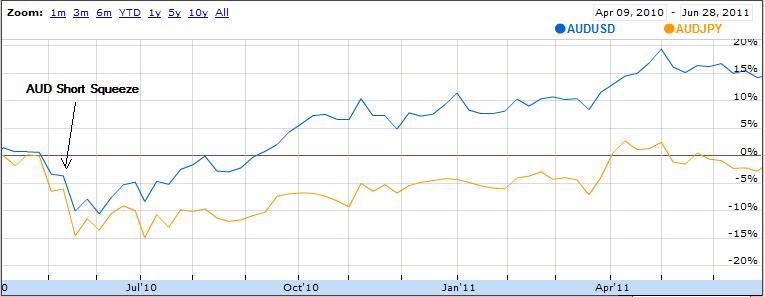
Ultimately, as one commentator recently pointed out, the Aussie’s 70% rise since 2008 might better be seen as US Dollar weakness (which also catalyzed the rise in commodity prices). The apparent stabilizing of the dollar, then, might let some air out of the currency down under.
Emerging Market Currencies Brace for Correction
“It was the spring of hope, it was the winter of despair,” begins Charles Dickens’ The Tale of Two Cities. In 2011, the winter of despair was followed by the spring of uncertainty. Due to the earthquake/tsunami in Japan, the continued tribulations of Greece, rising commodity prices, and growing concern over the global economic recovery, volatility in the forex markets has risen, and investors are unclear as to how to proceed. For now at least, they are responding by dumping emerging market currencies.
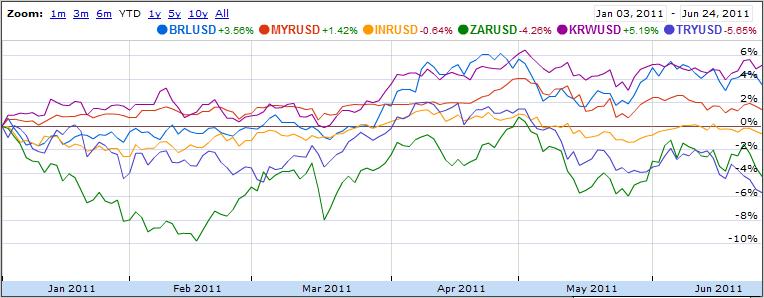
As you can see from the chart above (which shows a cross-section of emerging market forex), most currencies peaked in the beginning of May and have since sold-off significantly. If not for the rally that started off the year, all emerging market currencies would probably be down for the year-to-date, and in fact many of them are anyway. Still, the returns for even the top performers are much less spectacular than in 2009 and 2010. Similarly, the MSCI Emerging Markets Stock Index is down 3.5% in the YTD, and the JP Morgan Emerging Market Bond Index (EMBI+) has risen 4.5% (which is reflects declining growth forecasts as much as perceptions of increasing creditworthiness).
There are a couple of factors that are driving this ebbing of sentiment. First of all, risk appetite is waning. Over the last couple months, every flareup in the eurozone debt crisis coincided with a sell-off in emerging markets. According to the Wall Street Journal, “Central and eastern European currencies that are seen as being most vulnerable to financial turmoil in the euro zone have underperformed.” Economies further afield, such as Turkey and Russia, have also experienced weakness in their respective currencies. Some analysts believe that because emerging economies are generally more fiscally sound than their fundamental counterparts, that they are inherently less risky. Unfortunately, while this proposition makes theoretical sense, you can be assured that a default by a member of the eurozone will trigger a mass exodus into safe havens – NOT into emerging markets.
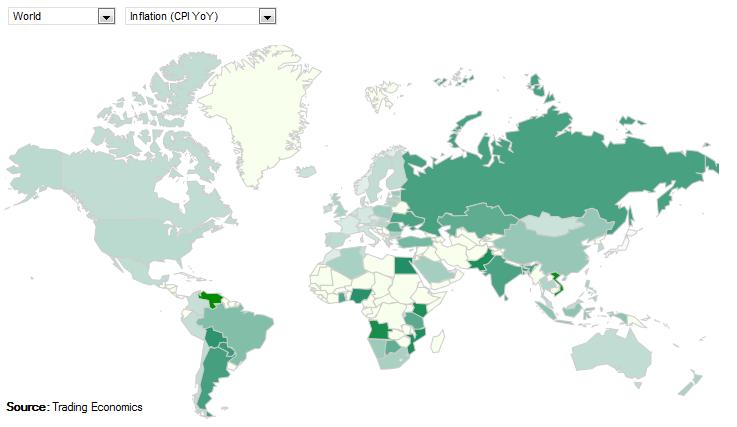
While emerging market Asia and South America is somewhat insulated from eurozone fiscal problems. On the other hand, they remain vulnerable to an economic slowdown in China and to rising inflation. Emerging market central banks have avoided making significant interest rate hikes (hence, rising bond prices) – for fear of inviting further capital inflow and stoking currency appreciation – and the result has been rising price inflation. You can see from the chart above that the darkest areas (symbolizing higher inflation) are all located in emerging economic regions. While high inflation is not inherently problematic, it is not difficult to conceive of a downward spiral into hyperinflation. Again, a sudden bout of monetary instability would send investors rushing to the exits.
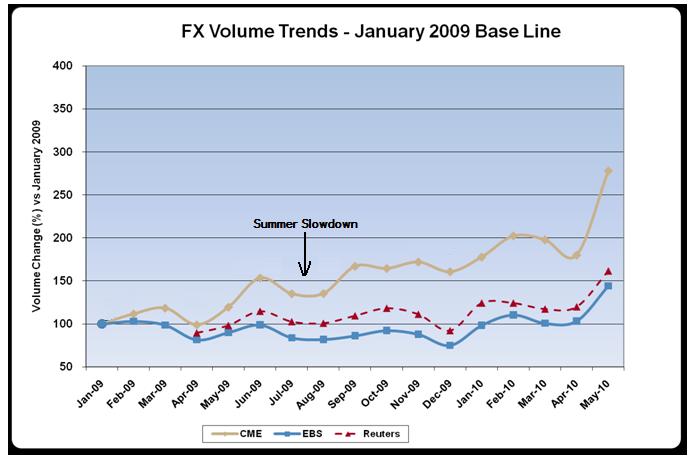
While most analysts (myself included) remain bullish on emerging markets over the long-term, many are laying off in the short-term. “RBC emerging market strategist Nick Chamie says his team has recommended ‘defensive posturing’ to clients since May 5 and isn’t recommending new bullish emerging currency bets right now….HSBC said Thursday that it isn’t recommending outright short positions on emerging market currencies to clients but suggested a more ‘cautious’ and selective approach in making currency bets.” This phenomenon will be exacerbated by the fact that market activity typically slows down in the summer chart above courtesy of Forex Magnates) as traders go on vacation. With less liquidity and an inability to constantly monitor one’s portfolio, traders will be loathe to take on risky positions.
Loonie and Aussie Share Downward Bond
In yesterday's post ( Tide is Turning for the Aussie ), I explained how a prevailing sense of uncertainty in the markets has manifested itself in the form of a declining Australian Dollar. With today's post, I'd like to carry that argument forward to the Canadian Dollar.
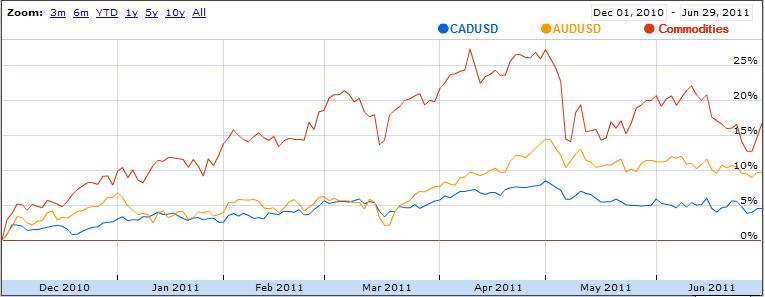
As it turns out, the forex markets are currently treating the Loonie and the Aussie as inseparable. According to Mataf.net , the AUD/USD and CAD/USD are trading with a 92.5% correlation, the second highest in forex (behind only the CHFUSD and AUDUSD). The fact that the two have been numerically correlated (see chart below) for the better part of 2011 can also be discerned with a cursory glance at the charts above.

Why is this the case? As it turns out, there are a handful of reasons. First of all, both have earned the dubious characterization of “commodity currency,” which basically means that a rise in commodity prices is matched by a proportionate appreciation in the Aussie and Loonie, relative to the US dollar. You can see from the chart above that the year-long commodities boom and sudden drop corresponded with similar movement in commodity currencies. Likewise, yesterday's rally coincided with the biggest one-day rise in the Canadian Dollar in the year-to-date.
Beyond this, both currencies are seen as attractive proxies for risk. Even though the chaos in the eurozone has very little actual connection to the Loonie and Aussie (which are fiscally sound, geographically distinct, and economically insulated from the crisis), the two currencies have recently taken their cues from political developments in Greece, of all things. Given the heightened sensitivity to risk that has arisen both from the sovereign debt crisis and global economic slowdown, it's no surprise that investors have responded cautiously by unwinding bets on the Canadian dollar.
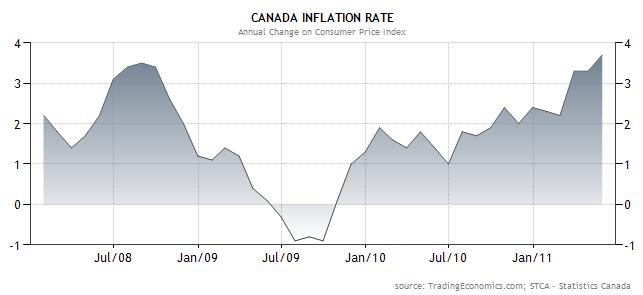
Finally, the Bank of Canada is in a very similar position to the Reserve Bank of Australia (RBA). Both central banks embarked on a cycle of monetary tightening in 2010, only to suspend rate hikes in 2011, due to uncertainty over near-term growth prospects. While GDP growth has indeed moderated in both countries, price inflation has not. In fact, the most recent reading of Canadian CPI was 3.7%, which is well above the BOC's comfort zone. Further complicating the picture is the fact that the Loonie is near a record high, and the BOC remains wary of further stoking the fires of appreciation by making it more attractive to carry traders.
In the near-term, then, the prospects for further appreciation are not good. The currency's rise was so solid in 2009-2010 that it now seems the forex markets may have gotten ahead of themselves. A pullback towards parity – and beyond – seems like the only realistic possibility. If/when the global economy stabilizes, central banks resume heightening, and risk appetite increases, you can be sure that the Loonie (and the Aussie) will pick up where they left off.


As it turns out, the forex markets are currently treating the Loonie and the Aussie as inseparable. According to Mataf.net , the AUD/USD and CAD/USD are trading with a 92.5% correlation, the second highest in forex (behind only the CHFUSD and AUDUSD). The fact that the two have been numerically correlated (see chart below) for the better part of 2011 can also be discerned with a cursory glance at the charts above.

Why is this the case? As it turns out, there are a handful of reasons. First of all, both have earned the dubious characterization of “commodity currency,” which basically means that a rise in commodity prices is matched by a proportionate appreciation in the Aussie and Loonie, relative to the US dollar. You can see from the chart above that the year-long commodities boom and sudden drop corresponded with similar movement in commodity currencies. Likewise, yesterday's rally coincided with the biggest one-day rise in the Canadian Dollar in the year-to-date.
Beyond this, both currencies are seen as attractive proxies for risk. Even though the chaos in the eurozone has very little actual connection to the Loonie and Aussie (which are fiscally sound, geographically distinct, and economically insulated from the crisis), the two currencies have recently taken their cues from political developments in Greece, of all things. Given the heightened sensitivity to risk that has arisen both from the sovereign debt crisis and global economic slowdown, it's no surprise that investors have responded cautiously by unwinding bets on the Canadian dollar.

Finally, the Bank of Canada is in a very similar position to the Reserve Bank of Australia (RBA). Both central banks embarked on a cycle of monetary tightening in 2010, only to suspend rate hikes in 2011, due to uncertainty over near-term growth prospects. While GDP growth has indeed moderated in both countries, price inflation has not. In fact, the most recent reading of Canadian CPI was 3.7%, which is well above the BOC's comfort zone. Further complicating the picture is the fact that the Loonie is near a record high, and the BOC remains wary of further stoking the fires of appreciation by making it more attractive to carry traders.
In the near-term, then, the prospects for further appreciation are not good. The currency's rise was so solid in 2009-2010 that it now seems the forex markets may have gotten ahead of themselves. A pullback towards parity – and beyond – seems like the only realistic possibility. If/when the global economy stabilizes, central banks resume heightening, and risk appetite increases, you can be sure that the Loonie (and the Aussie) will pick up where they left off.
Tide is Turning for the Aussie
“Australia is about to enter a boom that should last decades…The Australian dollar is unlikely to go back to where it was, and manufacturing will shrink in importance to the economy, perhaps even faster than it has been.” This, according to Martin Parkinson, Treasury Minister of Australia . While 30 years from now, Mr. Parkinson's prognosis might probe to be accurate, I'm not so sure it applies to the period 3 months from now. Here's why:
First of all, the putative economic boom that is taking place in Australia is being driven entirely by high commodity prices and surging production and exports. Since peaking at the end of April, commodity prices have fallen mightily. You can see from the chart above that there continues to exist a tight correlation between the AUD/USD and commodities prices. As commodities prices have fallen over the last two months, so has the Australian Dollar.

In addition, while demand will probably remain strong over the long-term, it may very well slacken over the short-term, due to declining economic growth across the industrialized world. Consider also that Australia's largest market for commodity exports – China – may have difficulty sustaining a GDP growth rate of 10%, and at the very least, new fixed-asset investment (which necessitates demand for raw materials) will temporarily peak in the immediate future.
Finally, the mining sector directly accounts for only 8% of Australia's economy, which means that only to a limited extent to high commodities prices contribute to the bottom line of Australian GDP. This notion is reinforced by the 1.2% economic contraction in the second quarter – the biggest decline in 20 years – and the fact that GDP is basically flat over the last three quarters. Many non-mining economic indicators are sagging, and the number ofcorporate bankruptcies is 10% higher than in 2010. In the end, then, the ebb and flow of Australia's fortune depends less on commodities, and more on other sectors.

Mr. Parkinson's optimistic forecasts might also be undermined in the short-term by a looser-than-expected monetary policy. The Reserve Bank of Australia last hiked its benchmark interest rate in November 2010, and may not hike again for a few more months due to moderating economic growth and proportionally moderate inflation. Given that an attractive interest rate differential may be driving some of the speculative activity that has girded the Aussie's rise, a decline in this differential could likewise propel it downward.
That's because anecdotal reports suggest that the Australian Dollar remains a popular long currency for carry traders, funded by shorting the US Dollar, and to a lesser extent, Japanese Yen. Given that many of these carry trades are heavily leveraged, it wouldn't take much to trigger a short squeeze and a rapid decline in the AUD/USD. For evidence of this phenomenon, one has to look no further back than May 2010, when the Aussie fell 10-15% in only three weeks.

Ultimately, as one commentator recently pointed out, the Aussie's 70% rise since 2008 might better be seen as US Dollar weakness (which also catalyzed the rise in commodity prices).The apparent stabilizing of the dollar , then, might let some air out of the currency down under.
First of all, the putative economic boom that is taking place in Australia is being driven entirely by high commodity prices and surging production and exports. Since peaking at the end of April, commodity prices have fallen mightily. You can see from the chart above that there continues to exist a tight correlation between the AUD/USD and commodities prices. As commodities prices have fallen over the last two months, so has the Australian Dollar.

In addition, while demand will probably remain strong over the long-term, it may very well slacken over the short-term, due to declining economic growth across the industrialized world. Consider also that Australia's largest market for commodity exports – China – may have difficulty sustaining a GDP growth rate of 10%, and at the very least, new fixed-asset investment (which necessitates demand for raw materials) will temporarily peak in the immediate future.
Finally, the mining sector directly accounts for only 8% of Australia's economy, which means that only to a limited extent to high commodities prices contribute to the bottom line of Australian GDP. This notion is reinforced by the 1.2% economic contraction in the second quarter – the biggest decline in 20 years – and the fact that GDP is basically flat over the last three quarters. Many non-mining economic indicators are sagging, and the number ofcorporate bankruptcies is 10% higher than in 2010. In the end, then, the ebb and flow of Australia's fortune depends less on commodities, and more on other sectors.

Mr. Parkinson's optimistic forecasts might also be undermined in the short-term by a looser-than-expected monetary policy. The Reserve Bank of Australia last hiked its benchmark interest rate in November 2010, and may not hike again for a few more months due to moderating economic growth and proportionally moderate inflation. Given that an attractive interest rate differential may be driving some of the speculative activity that has girded the Aussie's rise, a decline in this differential could likewise propel it downward.
That's because anecdotal reports suggest that the Australian Dollar remains a popular long currency for carry traders, funded by shorting the US Dollar, and to a lesser extent, Japanese Yen. Given that many of these carry trades are heavily leveraged, it wouldn't take much to trigger a short squeeze and a rapid decline in the AUD/USD. For evidence of this phenomenon, one has to look no further back than May 2010, when the Aussie fell 10-15% in only three weeks.

Ultimately, as one commentator recently pointed out, the Aussie's 70% rise since 2008 might better be seen as US Dollar weakness (which also catalyzed the rise in commodity prices).The apparent stabilizing of the dollar , then, might let some air out of the currency down under.














